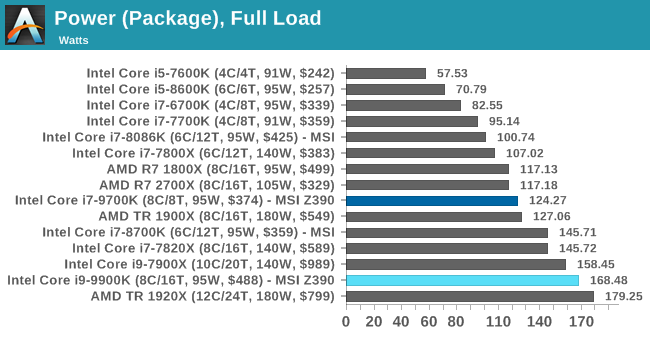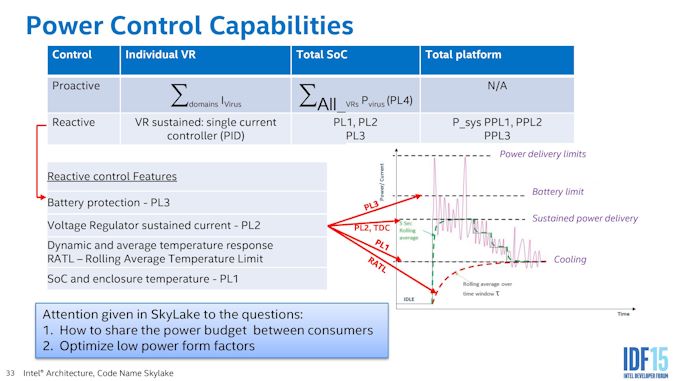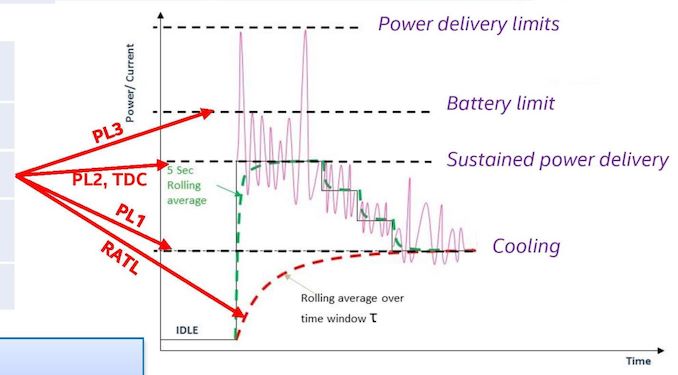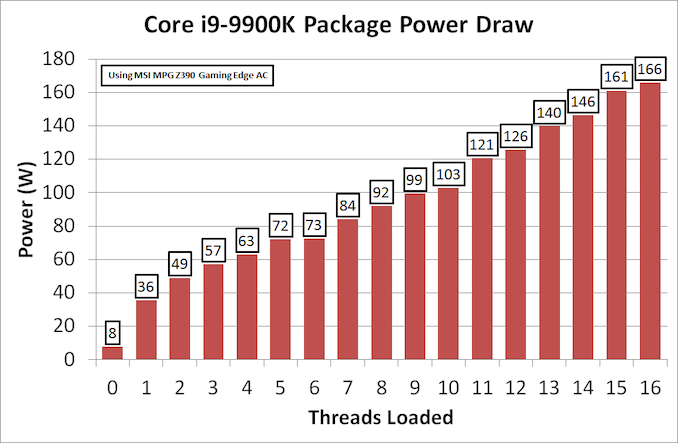The Intel 9th Gen Review: Core i9-9900K, Core i7-9700K and Core i5-9600K Tested
by Ian Cutress on October 19, 2018 9:00 AM EST- Posted in
- CPUs
- Intel
- Coffee Lake
- 14++
- Core 9th Gen
- Core-S
- i9-9900K
- i7-9700K
- i5-9600K
Power Consumption
TDP or not the TDP, That is The Question
Notice: When we initially posted this page, we ran numbers with an ASRock Z370 board. We have since discovered that the voltage applied by the board was super high, beyond normal expectations. We have since re-run the numbers using the MSI MPG Z390 Gaming Edge AC motherboard, which does not have this issue.
As shown above, Intel has given each of these processors a Thermal Design Power of 95 Watts. This magic value, as mainstream processors have grown in the last two years, has been at the center of a number of irate users.
By Intel’s own definitions, the TDP is an indicator of the cooling performance required for a processor to maintain its base frequency. In this case, if a user can only cool 95W, they can expect to realistically get only 3.6 GHz on a shiny new Core i9-9900K. That magic TDP value does not take into account any turbo values, even if the all-core turbo (such as 4.7 GHz in this case) is way above that 95W rating.
In order to make sense of this, Intel uses a series of variables called Power Levels: PL1, PL2, and PL3.
That slide is a bit dense, so we should focus on the graph on the right. This is a graph of power against time.
Here we have four horizontal lines from bottom to top: cooling limit (PL1), sustained power delivery (PL2), battery limit (PL3), and power delivery limit.
The bottom line, the cooling limit, is effectively the TDP value. Here the power (and frequency) is limited by the cooling at hand. It is the lowest sustainable frequency for the cooling, so for the most part TDP = PL1. This is our ‘95W’ value.
The PL2 value, or sustained power delivery, is what amounts to the turbo. This is the maximum sustainable power that the processor can take until we start to hit thermal issues. When a chip goes into a turbo mode, sometimes briefly, this is the part that is relied upon. The value of PL2 can be set by the system manufacturer, however Intel has its own recommended PL2 values.
In this case, for the new 9th Generation Core processors, Intel has set the PL2 value to 210W. This is essentially the power required to hit the peak turbo on all cores, such as 4.7 GHz on the eight-core Core i9-9900K. So users can completely forget the 95W TDP when it comes to cooling. If a user wants those peak frequencies, it’s time to invest in something capable and serious.
Luckily, we can confirm all this in our power testing.
For our testing, we use POV-Ray as our load generator then take the register values for CPU power. This software method, for most platforms, includes the power split between the cores, the DRAM, and the package power. Most users cite this method as not being fully accurate, however compared to system testing it provides a good number without losses, and it forms the basis of the power values used inside the processor for its various functions.
Starting with the easy one, maximum CPU power draw.

Focusing on the new Intel CPUs we have tested, both of them go beyond the TDP value, but do not hit PL2. At this level, the CPU is running all cores and threads at the all-core turbo frequency. Both 168.48W for the i9-9900K and 124.27W for the i7=9700K is far and above that ‘TDP’ rating noted above.
Should users be interested, in our testing at 4C/4T and 3.0 GHz, the Core i9-9900K only hit 23W power. Doubling the cores and adding another 50%+ to the frequency causes an almost 7x increase in power consumption. When Intel starts pushing those frequencies, it needs a lot of juice.
If we break out the 9900K into how much power is consumed as we load up the threads, the results look very linear.
This is as we load two threads onto one core at a time. The processor slowly adds power to the cores when threads are assigned.
Comparing to the other two ‘95W’ processors, we can see that the Core i9-9900K pushes more power as more cores are loaded. Despite Intel officially giving all three the same TDP at 95W, and the same PL2 at 210W, there are clear differences due to the fixed turbo tables embedded in each BIOS.
So is TDP Pointless? Yes, But There is a Solution
If you believe that TDP is the peak power draw of the processor under default scenarios, then yes, TDP is pointless, and technically it has been for generations. However under the miasma of a decade of quad core processors, most parts didn’t even reach the TDP rating even under full load – it wasn’t until we started getting higher core count parts, at the same or higher frequency, where it started becoming an issue.
But fear not, there is a solution. Or at least I want to offer one to both Intel and AMD, to see if they will take me up on the offer. The solution here is to offer two TDP ratings: a TDP and a TDP-Peak. In Intel lingo, this is PL1 and PL2, but basically the TDP-Peak takes into account the ‘all-core’ turbo. It doesn’t have to be covered under warranty (because as of right now, turbo is not), but it should be an indication for the nature of the cooling that a user needs to purchase if they want the best performance. Otherwise it’s a case of fumbling in the dark.














274 Comments
View All Comments
leexgx - Saturday, October 20, 2018 - link
Can you please stop your website playing silent audio, very annoying as it stops playback on my other phone (dual connection headset)moozooh - Sunday, October 21, 2018 - link
To be fair, the 9900K seems like a suboptimal choice for a gaming rig despite the claims—the extra performance is marginal and comes at a very heavy price. Consider that in all the CPU-bound 95th percentile graphs (which are the only important ones in this context)—even in the more CPU-intensive games—the 9700K was within 5% of the 9900K, sometimes noticeably faster (e.g. Civ6 Low). And its overclocking potential is just *so* much better—all of this at ~3/4 the price and power consumption (and hence more relaxed cooling requirements and lower noise). I cannot possibly envision a scenario where a rational choice, all this considered, would point to 9900K for a gaming machine. The at most 5% extra performance just isn't worth the downsides.On a sidenote, I'd actually like to see how an overclocked 9700K fares against overclocked 8700K/8086K (delidded for fair comparison—you seem to have had at least one of those, no?) with regards to frame times/worst performance. For my current home PC I chose a delidded 8350K running at 4.9 GHz on 1–2 cores and at 4.7 GHz on 3–4, which I considered the optimal choice for my typical usage, where the emphasis lies on non-RTS games, general/web/office performance, emulation, demoscene, some Avisynth—basically all of the tasks that heavily favor per-thread performance and don't scale well with HT. In most of the gaming tests the OC 8350K showed frame times about on par with the twice more expensive 8700K at stock settings, so it made perfect sense as a mid-tier gaming CPU. It appears that 9700K would be an optimal and safe drop-in replacement for it as it would double the number of cores while enabling even better per-thread performance without putting too much strain on the cooler. But then again I'd be probably better off waiting for its Ice Lake counterpart with full (?) hardware Spectre mitigation, which should result in a "free" minor performance bump if nothing else. At least assuming it will still use the same socket, which you never can tell with Intel...
R0H1T - Sunday, October 21, 2018 - link
Ryan & Ian, I see that the last few pages have included a note about Z390 used because the Z370 board was over-volting the chip? Yet on the Overclocking page we see the Z370 listed with max CPU package power at 168 Watts? Could you list the (default) auto voltage applied by the Asrock Z370 & if appropriate update the charts on OCing page with the Z390 as well?Total Meltdowner - Sunday, October 21, 2018 - link
Ryan, you do great work. Please don't let all these haters in the comments who constantly berate you over grammar and typos get you down.Icehawk - Saturday, October 27, 2018 - link
Ryan, I still haven't been able to find an answer to this - what are your actual HEVC settings? Because I've got an 8700 @4.5 no offset and it does 1080p at "1080p60 HEVC at 3500 kbps variable bit rate, fast setting, main profile" with passthrough audio and I get ~40fps not the 175 you achieved - how on earth are you getting over 4x the performance??? The only way I can get remotely close would be to use NVENC or QuickSync neither of which are acceptable to me.phinnvr6@gmail.com - Wednesday, October 31, 2018 - link
My thoughts are why would anyone recommend the 9900K over the 9700K? It's absurdly priced, draws an insane amount of power, and performs roughly identical.DanNeely - Friday, October 19, 2018 - link
Have any mobo makers published block diagrams for their Z390 boards? I'm wondering if the 10GB USB3.1 ports are using 2 HSIO lanes as speculated in the mobo preview article, or if Intel has 6 lanes that can run at 10gbps instead of the normal 8 so that they only need one lane each.repoman27 - Friday, October 19, 2018 - link
They absolutely do not use 2 HSIO lanes. That was a total brain fart in the other article. The datasheet for the other 300 series chipsets is available on ARK, and the HSIO configuration of the Z390 can easily be extrapolated from that.HSIO lanes are just external connections to differential signaling pairs that are connected internally to either various controllers or a PCIe switch via muxes. They’re analog interfaces connected to PHYs. They operate at whatever signaling rate and encoding scheme the selected PHY operates at. There is no logic to perform any type of channel bonding between the PCH and any connected ports or devices.
TEAMSWITCHER - Friday, October 19, 2018 - link
My big question ... Could there be an 8 core Mobile part on the way?Ryan Smith - Friday, October 19, 2018 - link
We don't have it plotted since we haven't taken enough samples for a good graph, but CFL-R is showing a pretty steep power/frequency curve towards the tail-end. That means power consumption drops by a lot just by backing off of the frequency a little.So while it's still more power-hungry than the 6-cores at the same frequencies, it's not out of the realm of possibility. Though base clocks (which are TDP guaranteed) will almost certainly have to drop to compensate.